News & Views
Reflections: Wild Cycling
Kathy Tiernan discovers the delights of wild places during the Covid-19 lockdown
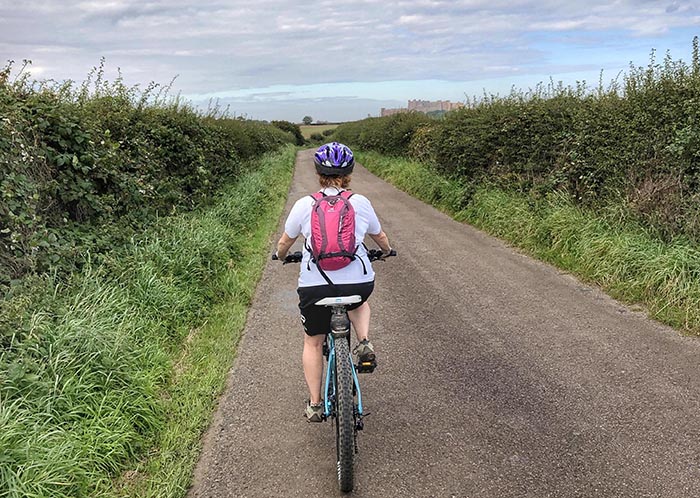
Woman (not Kathy) cycling toward Bamburgh Castle, Northumberland
Lockdown brought a new joy. It could have happened at any time but for sure, that lockdown sense of irksome confinement was the spur. A few years ago I suffered a tendon injury in my right foot that became a chronic condition. In the early stages of the injury I was crippled and sometimes reduced to a wheelchair. I can walk now, but a mile or two is my limit. Before the injury I used to be something of a walker. My go-to antidote to stress was to pull on my hiking boots and head outdoors. I took up swimming as a substitute, even gym sessions, but it wasn’t the same. So when lockdown shut down the leisure centre I got out my bike and started to experiment. I would cycle a mile or two out of town, enjoy as much walking as I could manage and then cycle home.
One fine afternoon a few weeks into lockdown I cycled out to a wood on the outskirts of town. I passed as usual the blue Sustrans [/] sign for the cycle route inland to the country house estate of Paxton, seven or eight miles distant. Nothing, you might think, for an averagely fit cyclist. But I’d been convinced I could not manage anything like that. I wasn’t fit enough, and anyway, the tendon started to give trouble when I cycled any distance.
But that sunny afternoon a recklessness seized me. I tucked my walking stick into the pannier and turned off onto the cycle route, over the bypass and onto the country road that leads to Paxton. The transition was almost instantaneous. I was no longer on the outskirts of town, I was out and away into countryside, with hedges and fields on either side and a whiff of manure in my nostrils. I felt a great rush of freedom. Here I was, just me and my bike, spinning along as sweetly as could be with spring breaking out in the hedgerows and not a soul on the road. My elation was mixed with apprehension. Was this safe? Would the tendon collapse so that I’d be unable to get home? My mobile was on the kitchen table. But the delight of the spring air on my face, of my body moving without constraint, was irresistible. I pedalled onwards.
I made it to Paxton, closed of course, but the grounds still open. I left the bike and lay on my back under the lime trees and gazed up at the sun filtering through the leaves, my heart still thudding with excitement. Everything seemed OK. The tendon didn’t hurt. I had escaped.
When I turned for home the skies clouded to a cheerless grey and I discovered that my carefree pelt along the road owed less to my thigh muscles than to the wind behind me. Now I had to crouch low over the handlebars and pedal in earnest against the biting blow. My legs started to ache. But I didn’t care. A new vista had opened before me and I was going to take it.
What that first expedition taught me, kitted out as I was for walking rather than cycling, was that the stiff walking boots enabled me to cycle without compromising the tendon. It was to be a liberating discovery. I embarked on a new discovery of the natural world that lies around the small market town where I live. I became a wild cyclist.
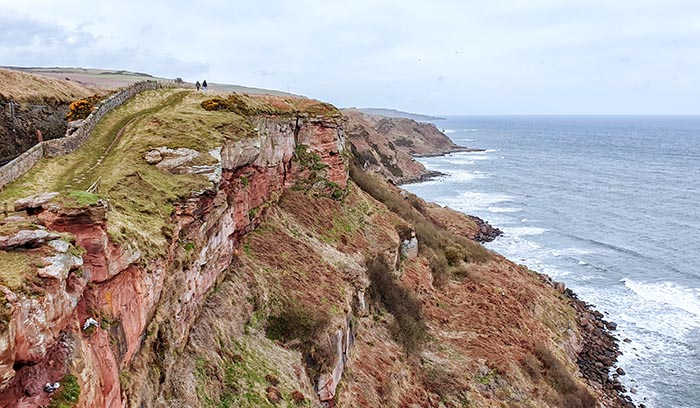
The coastal path between Berwick and Burnmouth, Northumberland. Photograph: R. Scapinello / istock
The Lure of the Wild
.
Wild swimming, which has also enjoyed a surge of interest during the pandemic, is about the experience of sea and river rather than notching up the lengths. Wild cycling, in my definition, is on the same page. It is not about lycra, mile-tracking apps and fanatical fitness. Though it helps to have a reasonable level of fitness, it is a means to an end. And the end is the freedom to be out in wild places, to experience wildness without cars or even roads. As Roger Deakin puts it in Waterlog,[1] his book about his wild swimming adventures:
Most of us live in a world where more and more things are signposted, labelled, and officially ‘interpreted’. There is something about all this that is turning the reality of things into virtual reality. It is the reason why walking, cycling and swimming will always be subversive activities. They allow us to regain a sense of what is old and wild in these islands, by getting off the beaten track and breaking free of the official version of things.
And there is wildness to be had. North Northumberland is still in places a pristine landscape. The coastline south of Berwick down to Holy Island, Bamburgh and beyond is an ‘Area of Outstanding Natural Beauty’ [/] and within it sits the Lindisfarne National Nature Reserve [/]. To the west is a band of rich arable farmland that gives way to the foothills of the Cheviots. Let me take you there.
It starts, as every ride out of Berwick does, uphill. Our house sits on the Tweed estuary, so the way out is always up. After a mile of breathless struggle the long pull up the hill ends with a sudden roar of SUVs and cattle wagons jostling at the roundabout. The bicycle feels suddenly frail. Too risky to ride here, I dodge through the exhaust rush on foot. In the early days of lockdown the roads emptied and the bypass was stilled; cyclists ruled the roads for a while and there was birdsong in place of engine roar. It was a memento mori; a reminder of the transience of our domineering of nature. But now the traffic is back with a vengeance.
The bypass is like the fairy-tale hedge of thorns; once surmounted, the open countryside lies seductively beyond. Berwick is like that. Originally a walled town, its settlement has always been enclosed within boundaries. In the twentieth century the bypass usurped the place of city walls and now the housing estates and suburban straggle of the town sit within its compass. Once outside it you breathe a different air, a different time and place.
After a couple of miles west I head onto a single-track road up to Middle Ord, a settlement sitting on a high hill overlooking the town. There is a stand of Scots pine and outcrops of sandstone cliff that give the landscape a moorland feel, remote and atmospheric. I love this unexpected pocket of wilderness, just a few miles from town. It is not for the faint-hearted though. Spinning downhill from Middle Ord you find yourself confronted at the bottom with the longest, steepest hill ever scaled. When I first encountered this climb there were two horse riders trotting along behind me and pride compelled me to try and keep cycling. About halfway up, gasping and exhausted, I admitted defeat and waved politely as they passed me.

Hedgerow in spring. Photograph: Terry Mathews [/] / Alamy Stock Photo
Now I take a different attitude. This is wild cycling, after all. I make a token effort to cycle up part the way before getting off and pushing. The road is hardly used and I have an undisturbed twenty or thirty minutes enjoying the hedge alongside me as I trudge upwards. It is the kind of hedge seldom found in more intensive agricultural landscapes, a complete ecosystem as various as a coral reef. It is still top-trimmed but otherwise left to its own devices. The structure is mature hawthorn, kept to a height of around five foot, intergrown with hazel, blackthorn, wild rose, gorse, elder and blackberry, and a few wind-stunted beech and oak given leave to grow higher than the rest. Bracken and long grass grow through the base so that it is a completely dense shelter within and without for sheep, rabbits, birds’ nests and roosts, voles, mice and every kind of insect. In the verge alongside, wildflowers grow up and through it too, purple vetch coiling through the blackberry, hogweed, hawkbit, ladies bedstraw, yarrow, knapweed, nettle, a floral litany I learned in childhood and which transports me there again.
Then, at last, the hill is surmounted and over to the west, like a trumpet blast, the distant range of the Cheviots comes sensationally, unpredictably, into view. There they are, in their awesome charcoal-dark stillness, a waiting presence high above the fields and valleys. It is like coming upon Uluru unawares. How breath-taking that the mountains should be here, hardly six miles into the ride; you feel unworthy of such a sight, as if you should have cycled much harder, much further, to have deserved it. I prop the bike against the fence, get out the flask and sit at the edge of the field, drinking tea and contemplating sublimity.
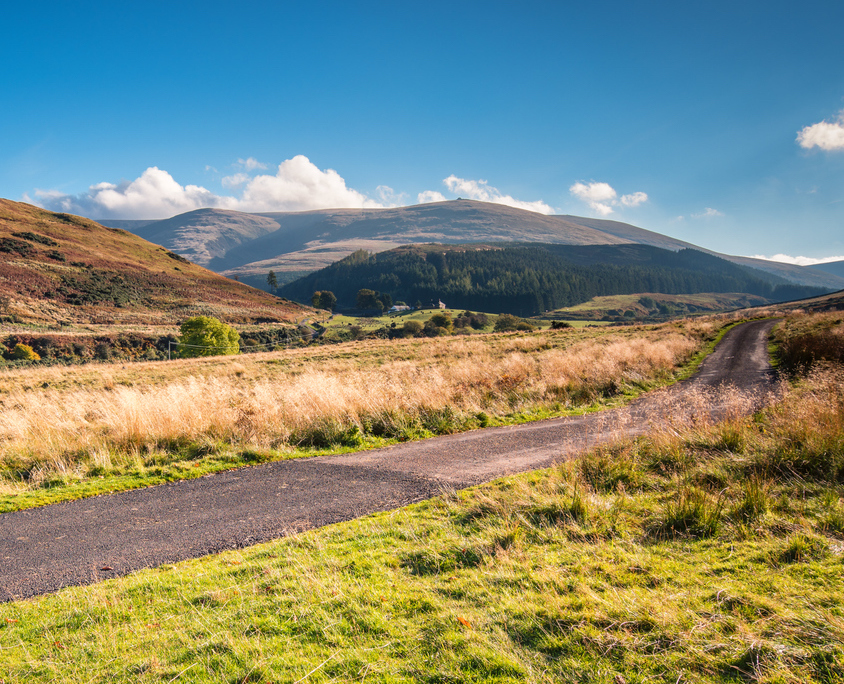
The Cheviot, the highest point in Northumberland. Photograph: daverhead / istock
The Endless Sea
.
Then onwards, with the Cheviots to my right, past unimproved scrubby pasture where black cows mooch among the reeds till I come to the junction where I turn to the coast. It is a long downhill run on good roads past fields where lone tractors work up and down the green deserts of arable, a chance to find a steady rhythm and enjoy the swift rush of air past my face. I am heading down towards the northernmost edge of the national nature reserve.
The land flattens away after crossing the A1. I cycle past low fields of oilseed rape and winter wheat and a couple of small hamlets on the edge of the reserve, last footholds of domesticity before the wilderness begins; endless expanses of sand-dunes covered in marram grass, combining and re-combining into pathless slacks, the dull green of the marram monotonous and alien as it flattens and lifts in the wind. Far beyond is the sea, an endless line of rising and breaking surf along the mile-long beach. When the tide is out the water recedes to a scarcely visible horizon and the expanse of sand stretches all the way to the tidal island of Lindisfarne.
This is nothing like a conventional beach with predictable limits of sand and sea. It is an edgeless emptiness that is almost always disturbing. I once attended a beach yoga class on the sands. A cold wind blew, the flat sand was muddy between our toes and our effortful yoga poses felt self-conscious and irrelevant. The emptiness seems to challenge all human activity with absurdity, as if the only thing to do in the space is to yield yourself up to it, to stand and absorb the immensity. Above, the sky is as wide and colourless as the sands beneath it. In the migration seasons it fills with huge skeins of pink-bellied Brent geese flying down from Svalbard to winter on the Lindisfarne mudflats. On one of my bike rides I stopped on the track while circling lines of geese passed over me on their descent into the field alongside, the bold dark outlines of their necks and wings endlessly repeated and the air full of their strident but guttural ka-ak! Ka-ak!
For all its bleakness there is something in such wild places that the spirit hungers after. It is the experience of desert; the stripping away of distraction and petty preoccupation. In the present uneasy times where nothing can be usual, when tension underlies our lives, the wilderness is a solace. Like the geese, the soul closes its wings and comes down to rest.
A dedicated cycle track along the back of the dunes allows the wild cyclist to be in the landscape in all its strangeness, the only messenger from civilisation the shuttling steel capsules along the neighbouring train line. The trains rush past in a susurration of overhead wires and sparking metal and are gone, racing through to Edinburgh or Newcastle, leaving the emptiness heightened by their passing.
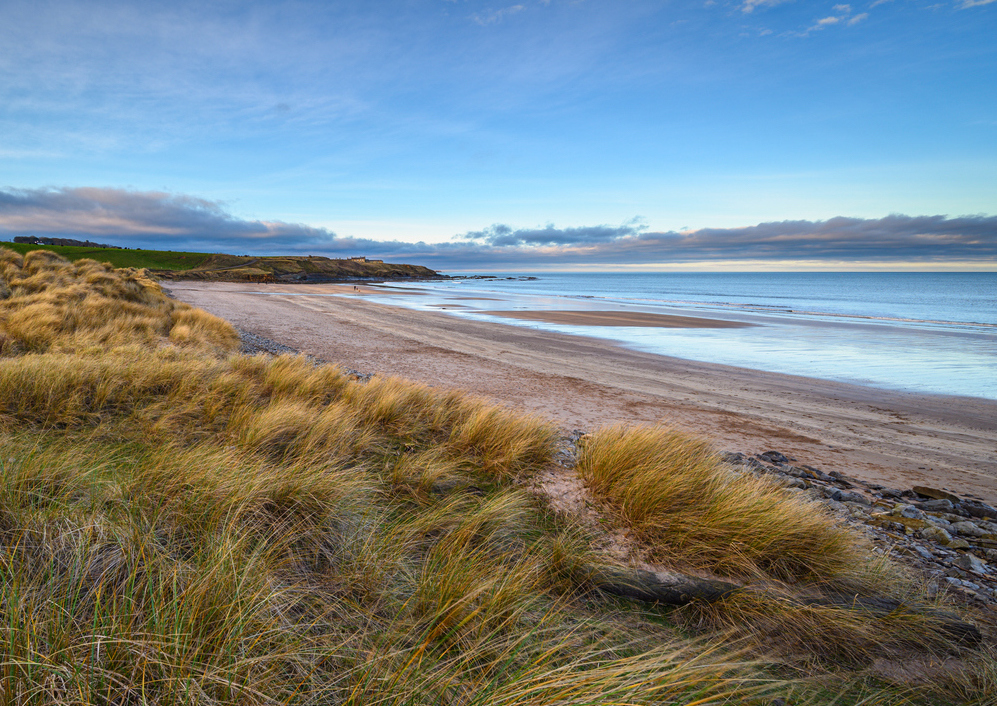
Cocklawburn Beach, near Berwick-upon-Tweed. Photograph: daverhead / istock
… And Home
.
The final section of the route takes me over a cliff-top cycle track better suited to mountain bikes than mine. As with the hedgerow hill I’ve learned to get off and walk the toughest sections. There’s a stunning view out over the sea, stretching in an indigo-blue expanse to the horizon. I think of Wendell Berry’s description of such a seascape:
… But the dark of the sea
Is perfect and strange,
The absence of any place,
Immensity on the loose.[2]
Sometimes dolphins breach in the bay below or visiting gannets circle and plunge vertiginously into shoals of mackerel. It is a last joyful immersion in the wild world before the descent into the seaside resort of Spittal, with its promenade, the Venetian Pavilion and its wind-whipped socially distanced tables where small children eat ice-creams.
And it’s fine to be back, fine to be home in the familiar streets, to feel the necessary harness of the everyday slipping back over my head. In my younger days I thought I wanted to live in the wild all the time, out on the hills miles from anywhere. But I just got lonely. I learned that we need both, the wild and the domestic, solitude and company. But all the same, when I catch a glance of my bike leaning against the bench outside, I feel my heart lift. Chained up safely here, we are complicit nevertheless in the secret of our wild adventures.
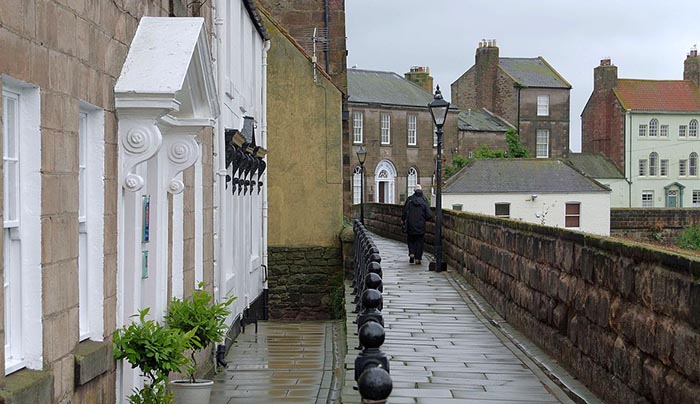
Berwick-upon-Tweed. Photograph: mattbuck via Wikimedia Commons
Kathy Tiernan is a writer who lives in Berwick-upon-Tweed, Northumberland. Her latest book, A New Heaven and a New Earth (Sacristy, 2020), was published in September and completes a trilogy on the life and heritage of St Cuthbert. See our interview.
The three books are now available as a set. Click here [/].
To follow Kathy’s blog, click here [/].
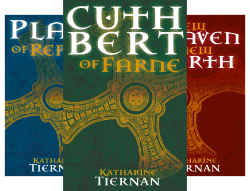
More News & Views
Book Review: ‘Conversations with Dostoevsky’
Andrew Watson engages with an innovative new book by George Pattison which explores Dostoevsky’s relevance in the contemporary world
Thich Nhat Hanh & the Poetry of Engaged Buddhism
Philip Brown presents the poem ‘Recommendation’ and comments on the potential of contemplative art to foster compassion
Introducing… ‘Perfect Days’ and ‘Nowhere Special’
Jane Clark watches two films with a contemplative theme
Irreducible: Consciousness, Life, Computers and Human Nature
Richard Gault reviews a new book by one of the leading lights of the science of consciousness
An Irish Atlantic Rainforest
Peter Mabey reviews a new book by Eoghan Daltun which presents an inspiring example of individual action in the face of climate change
In Memory of Bill Viola (1951–2024)
Jane Carroll pays tribute to the acclaimed video artist, who died on July 12th 2024
FOLLOW AND LIKE US
——————————————
——————————————
——————————————
Sources (click to open)
[1] ROGER DEAKIN, Waterlog (Vintage, New Edition, 2000).
[2] WENDELL BERRY, from ‘The Farmer and the Sea’ [LINK https://mondaypoems.blogspot.com/2014/11/the-farmer-and-sea.html] in Farming, A Handbook: Poems (Counterpoint, 2011).
If you enjoyed reading this article
Please leave a comment below.
Please also consider making a donation to support the work of Beshara Magazine. The magazine relies entirely on voluntary support. Donations received through this website go towards editorial expenses, eg. image rights, travel expenses, and website maintenance and development costs.
READERS’ COMMENTS
4 Comments
Submit a Comment
FOLLOW AND LIKE US
What a beautiful discovery to make during lockdown . When I went on my first cycling adventure in Normandy I too wore my walking boots for support! 15 years later I have the Lycra ( brilliant for cycling in the rain) and a titanium bike ( easier to carry on and off trains/ over footbridges/ over fences) but still with the sense of awe at the natural beauty and being shaped by the natural environment ; idling along in the sunshine or going faster to keep warm in the cold, following the contours of a river valley, or stopping somewhere to shelter from a huge downpour.
Thanks Sue, great to hear about your adventures – and feeling a bit jealous of that titanium bike! might be the next step…
I loved your article Kathy – felt transported along your cycle route with you almost smelling the hedgerows and hearing an incoming flock of geese. Not a cyclist, but as a wild swimmer I identify with shedding the ‘necessary harness of the everyday’ – so beautifully described – and plunging deep into nature.
Thanks for your lovely comment Jo. I’m an occasional wild swimmer too, though the North Sea is quite brisk at the moment!